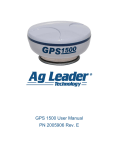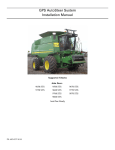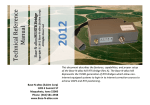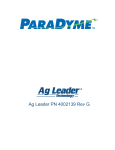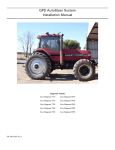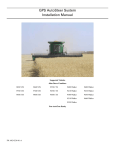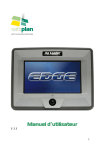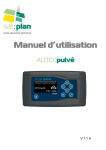Download ParaDyme Upgrade Kit Installation Manual
Transcript
ParaDyme Upgrade Kit Installation Manual PN: 602-0239-01-A LEGAL DISCLAIMER Note: Read and follow ALL instructions in this manual carefully before installing or operating the AutoSteer system. Note: Take careful note of the safety information in the Safety Information section and throughout this manual. The manufacturer disclaims any liability for damage or injury that results from failure to follow the instructions and warnings set forth herein. Please take special note of the following warnings: 1. There is NO obstacle avoidance system included in the manufacturer’s product. Therefore, users must always have an operator on the equipment when the AutoSteer system is in use to look for any obstacles including people, animals, trees, ditches, buildings, etc. 2. During installation of the AutoSteer system and during the Calibration and Tuning processes the vehicle's wheels turn from side to side and the vehicle moves. Be sure that all people and obstacles are clear of the vehicle before installation, calibration and tuning, or use of the AutoSteer system. 3. Use of the AutoSteer system is NOT permitted while the vehicle is on public roads or in public areas. Ensure that the system is OFF before driving on roads or in public areas. ii AutoSteer System Special Requirements Tools This list consists of the tools required to complete the installation. The installer is assumed to have a complete set of common installation tools. 11/32” open wrench #2 Phillips screwdriver Cleaning brush 3/8” open wrench #3 Phillips screwdriver Cleaning rags and supplies 7/16” open wrench Wire Cutters Tape Measure 12 ft minimum (4 m) 15/16” open wrench Portable Drill Ten foot ladder (3m) 17mm open wrench 13/64" or 7/32" drill bit (5mm or 5.5mm) 1/8” Allen wrench Hardware Installation Manual iii Safety Information Warning Alerts The AutoSteer system installer and manufacturer disclaim any responsibility for damage or physical harm caused by failure to adhere to the following safety requirements: • • As the operator of the vehicle, you are responsible for its safe operation. The AutoSteer system is not designed to replace the vehicle’s operator. Note: Verify all screws, bolts, nuts, and cable connections are tight after the final installation of the AutoSteer system on the vehicle. WARNING To avoid electrical shock hazards, remove the Roof Module from the vehicle before driving under low structures or low electrical power lines. WARNING To prevent injury from falling, ensure you are in a stable position on the vehicle when installing or removing the Roof Rail and Roof Module. If the vehicle does not provide a safe platform, use a ladder to safely access the vehicle roof while installing or removing the Roof Rail and Roof Module. WARNING To prevent accidental death or injury from being run over by the vehicle, never leave the vehicle's operator chair with the AutoSteer system engaged. iv AutoSteer System WARNING To understand the potential hazards associated with the operation of AutoSteer system equipment read the provided documentation before installing the AutoSteer system on a vehicle. WARNING To prevent the accidental engagement of AutoSteer and loss of vehicle control while driving on roads, shut down the AutoSteer system (exit the program). Never drive on roads or in public areas with the AutoSteer system turned on. Hardware Installation Manual v Caution Alerts The AutoSteer system installer and manufacturer disclaim any responsibility for damage or physical harm caused by failure to adhere to the following safety requirements: CAUTION The Roof Module must be removed when transporting or driving the vehicle at speeds above 30 mph (50 km/h). The Roof Module can possibly detach due to wind loads at higher speeds. CAUTION The AutoSteer system does not detect obstacles in the vehicle’s path. The operator must observe the path being driven in order to avoid obstacles. CAUTION When engaged, the AutoSteer system controls only the steering of the vehicle. The operator must control the speed of the vehicle. CAUTION The AutoSteer system must be powered OFF when installing or removing the Roof Module. vi AutoSteer System CAUTION The Roof Module must always be firmly secured to the Roof Rail using the hardware whenever the vehicle is in operation to prevent the Roof Module from releasing from its bracket and falling. Vehicle Requirements The vehicle steering system must be in good working order before installing the AutoSteer system. Check for loose or worn parts. Check the steering system hydraulic hoses and connections to ensure there are no oil leaks. The vehicle should be fully cleaned before installing the AutoSteer system. A clean vehicle will improve the overall installation and cable routing. Before installing the AutoSteer system, confirm the vehicle steering system is in good working order. Also, ensure the following system operations and components: • • • • • Check to see if you can turn the steered wheels from lock to lock. Ensure the vehicle steers straight. Check for loose or worn steering components. Ensure the hydraulic fluid level is correct. Ensure the vehicle electrical system and battery are in good working order. Service the vehicle if the steering is not in good working order. Hardware Installation Manual vii Important Information Note: Verify all screws, bolts, nuts, hose connection, and cable connections are tight after the final installation of the AutoSteer system on the vehicle. Technical Support Refer to your Display user manual for technical support information. Contact Information Refer to your Display user manual for contact information. Copyright © 2009 All Rights Reserved. viii AutoSteer System Table of Contents Chapter 1 Installation Overview ....................................................................................................... 1 Kit Overview . . . . . . . . . . . . . . . . . . . . . . . . . . . . . . . . . . . . . . . . . . . . . . . . . . . . . . . . . . . . . . . 1 Kit Components . . . . . . . . . . . . . . . . . . . . . . . . . . . . . . . . . . . . . . . . . . . . . . . . . . . . . . . . . . . 2 Kit Components . . . . . . . . . . . . . . . . . . . . . . . . . . . . . . . . . . . . . . . . . . . . . . . . . . . . . . . . . . . 3 Installation Procedure Outline . . . . . . . . . . . . . . . . . . . . . . . . . . . . . . . . . . . . . . . . . . . . . . . . . 4 Cable Diagram . . . . . . . . . . . . . . . . . . . . . . . . . . . . . . . . . . . . . . . . . . . . . . . . . . . . . . . . . . . . . 5 Chapter 2 Roof Module Installation.................................................................................................. 7 Safety Notes . . . . . . . . . . . . . . . . . . . . . . . . . . . . . . . . . . . . . . . . . . . . . . . . . . . . . . . . . . . . . . . . 7 Roof Module Installation . . . . . . . . . . . . . . . . . . . . . . . . . . . . . . . . . . . . . . . . . . . . . . . . . . . . . . 8 Chapter 3 Display Installation ......................................................................................................... 13 Introduction . . . . . . . . . . . . . . . . . . . . . . . . . . . . . . . . . . . . . . . . . . . . . . . . . . . . . . . . . . . . . . . 13 Installation Procedure . . . . . . . . . . . . . . . . . . . . . . . . . . . . . . . . . . . . . . . . . . . . . . . . . . . . . . . 13 Chapter 4 Connecting System Cables............................................................................................ 15 Main Cable Harness . . . . . . . . . . . . . . . . . . . . . . . . . . . . . . . . . . . . . . . . . . . . . . . . . . . . . . . . 16 Main Cable Harness Installation . . . . . . . . . . . . . . . . . . . . . . . . . . . . . . . . . . . . . . . . . . . . . 16 Main Cable Harness Connections Inside Cab . . . . . . . . . . . . . . . . . . . . . . . . . . . . . . . . . . . 22 Power Supply Connection . . . . . . . . . . . . . . . . . . . . . . . . . . . . . . . . . . . . . . . . . . . . . . . . . . . . 23 Cab Power Connection . . . . . . . . . . . . . . . . . . . . . . . . . . . . . . . . . . . . . . . . . . . . . . . . . . . . 23 Battery Power Connection . . . . . . . . . . . . . . . . . . . . . . . . . . . . . . . . . . . . . . . . . . . . . . . . . . 24 Chapter 5 Post-Installation Procedures and Information ............................................................. 25 Create New Vehicle . . . . . . . . . . . . . . . . . . . . . . . . . . . . . . . . . . . . . . . . . . . . . . . . . . . . . . . . . 25 Calibration and Tuning Guidelines . . . . . . . . . . . . . . . . . . . . . . . . . . . . . . . . . . . . . . . . . . . . . 25 Chapter 6 Final Hardware Installation Checklist ........................................................................... 27 Hardware Installation Manual ix x AutoSteer System 1 Installation Overview This Installation Overview chapter contains part numbers, kit overview diagram, cabling diagram and the installation procedure. • • • Kit Overview • Kit Components Kit Components Cable Diagram The ParaDyme upgrade kit includes all the parts required to upgrade an existing 2005-2010 AutoFarm A5 AutoSteer system to a new ParaDyme AutoSteer system. The only parts that will be replaced are the Main Cable Harness, Roof Rail and Display Mounting. The existing Steering Valve (when used), Wheel Angle Sensor, SA Module and Display Bracket remain on the machine and are fully compatible with the new ParaDyme AutoSteer system. Note: The installation procedures outlined in this manual are generic and are not specific to any single vehicle model. The pictures shown in this manual do not refer to any specific vehicle model however they are representative of most typical installations. You can expect differences in cable routing or hardware mounting procedures dependent on your specific vehicle model. Kit Overview This Kit Overview section is divided into sub-sections for each of its assemblies and their components are described in the following sections. Hardware Installation Manual 1 Kit Components Kit Components This assembly is shown in Figure 1-1 and its components are defined in Table 1-1. Figure 1-1 A5 to ParaDyme Kit Components (PN: 188-0043-01) Table 1-1 Installation Kit Components (PN: 188-0043-01) 2 Item Component Part Number 1. Common Assembly Kit 200-0497-02 2. Display Mounting Hardware 200-0508-01 3. Hardware Installation Manual 602-0239-01 4. Mounting Hardware 200-0076-01 5. Warning Labels 603-0074-01 AutoSteer System Kit Components Kit Components This assembly is shown in Figure 1-1 and its components are defined in Table 1-1. Figure 1-2 A5 to ParaDyme Kit Components (PN: 200-0497-02) Table 1-2 Installation Kit Components (PN: 200-0497-02) Item Component Part Number 1. Roof Rail Assembly 200-0515-01 2. Main Cable Harness 201-0426-02 3. Power Cable Harness 201-0475-01 Hardware Installation Manual 3 Installation Procedure Outline Installation Procedure Outline Note: The system interconnect cable diagram in the Cable Diagram on page 5 section of this chapter shows the AutoSteer electrical connections. 1. Verify shipped components. 2. Remove the existing A5 Roof Module and Roof Rail. 3. Install the ParaDyme Roof Rail on the cab roof. 4. Install the Roof Module on the Roof Rail. 5. Install the RAM Mount Ball inside the cab. 6. Install the Display using a RAM Mount Arm. 7. Install the Main Cable Harness and route cables to Roof Module and power connector. 8. Connect the Main Cable Harness to the Display Harness. 9. Connect the Main Cable Harness to the SA Module Harness. 10. Verify all connectors are properly coupled and secured. 11. Power ON the AutoSteer system. 12. Calibrate the vehicle. 13. Tune the vehicle. 14. Verify the system has been installed properly and operates satisfactorily. 4 AutoSteer System Cable Diagram Cable Diagram Hardware Installation Manual 5 Cable Diagram 6 AutoSteer System 2 Roof Module Installation This Roof Module Installation chapter contains information in the following sections: • • Safety Notes Roof Module Installation Safety Notes • • • • • The AutoSteer system must be powered OFF when installing or removing the Roof Module. The Roof Module must always be firmly secured to the Roof Rail using the hardware whenever the vehicle is in operation to prevent the Roof Module from releasing from its bracket and falling. The Roof Module must be removed when transporting the vehicle at speeds above 30 mph (48 km/h). Ensure you are in a stable position on the vehicle or ladder when removing the Roof Module, so that you do not fall or drop the Roof Module. Use a ladder to install the Roof Rail. WARNING Ensure that you are in a stable position on the vehicle when installing or removing the Roof Rail and Roof Module so you do not fall. Hardware Installation Manual 7 Roof Module Installation Roof Module Installation 1. Place the ladder as close as possible to the side of the cab. Note: The ladder is necessary to install the Roof Rail and Roof Module. 2. Disconnect the Main Cable Harness from the A5 Roof Module. 3. Remove the Locking Pin, and press the spring latch to slide off the existing A5 Roof Module. Figure 2-1 Remove A5 Roof Module 4. Remove the existing A5 Roof Rail. Use a 15/16" socket wrench or a wrench size that matches the existing mounting bolts. Figure 2-2 8 Remove A5 Roof Rail AutoSteer System Roof Module Installation 5. Inspect the existing mounting bolts and mounting brackets. Replace any parts that are damaged. Many rails are mounted directly on cab roofs while others may be mounted on adapter brackets. Figure 2-3 Inspect Mounting Bolts 6. Install the new ParaDyme Roof Rail across the existing mounting points. The rail end with the quick-release pin must be on the vehicle left side when looking forward. Figure 2-4 Quick Release Pin Hardware Installation Manual 9 Roof Module Installation 7. Attach the three antennas to the proper Roof Module antenna connections. See Figure 2-5. Note: Hand tighten the connections. Do not over tighten. Figure 2-5 Attach the Antennas WiFi Antenna Cell Phone Antenna RTK Modem Antenna 8. Install the ParaDyme Roof Module on the Roof Rail. Note: The Roof Module handle end should be on the vehicle left side when looking towards the vehicle front. Figure 2-6 10 Install Roof Module AutoSteer System Roof Module Installation 9. Insert the quick release pin across the holes in the rail from the front side. Confirm that the Roof Module is secured to the Roof Rail. Figure 2-7 Install Roof Module Hardware Installation Manual 11 Roof Module Installation 12 AutoSteer System 3 Display Installation This Display Installation chapter contains information for installing and adjusting the Display in the following sections: • • Introduction Installation Procedure Introduction This chapter provides the instructions for removing the existing A5 Display and installing the RAM Mount Ball in the cab so that the ParaDyme Display can be attached later. Refer to your Display user manual for instructions on installing the Display. Installation Procedure 1. Disconnect the Main Cable Harness from the A5 Display. Twist the connector sleeve counterclockwise to release. Figure 3-1 Disconnect A5 Harness Hardware Installation Manual 13 Installation Procedure 2. Remove the A5 Display and arm. A 1/8" hex key may be required to remove the display arm from the slider plate. Figure 3-2 Remove A5 Display 3. Remove the A5 slider plate from the bracket. Use a 7/16" wrench and Phillips screwdriver. 4. Drill four 7/32" holes on the existing steel bracket to mount the new RAM ball base. Use the RAM base as a template for drilling the holes. Secure the RAM base to the bracket using the four screws and locknuts provided in the kit. Note: Remove the bracket from the vehicle to drill the holes if the holes cannot be drilled in a safe manner. Take the necessary precautions to avoid damage to windows, panels or cab. Figure 3-3 Install RAM Mount Base Note: Refer to the Display user manual for the remaining Display-specific installation instructions. 14 AutoSteer System 4 Connecting System Cables This Connecting System Cables chapter provides information for connecting the Main Cable Harness and the SA Module Cable Harness to the various vehicle and AutoSteer components in the following sections: • • Main Cable Harness • Main Cable Harness Installation • Main Cable Harness Connections Inside Cab Power Supply Connection • Cab Power Connection • Battery Power Connection Note: The Cable Diagram shown on page 5 shows the AutoSteer system electrical connections. Hardware Installation Manual 15 Main Cable Harness Main Cable Harness This Main Cable Harness section contains the following sub-sections: • • Main Cable Harness Installation Main Cable Harness Connections Inside Cab Main Cable Harness Installation 1. Disconnect the A5 Main Cable Harness the power outlet. Figure 4-1 16 Disconnect Harness from A5 Display AutoSteer System Main Cable Harness Installation 2. Disconnect the A5 Main Cable Harness from the two connectors on the SAM harness. Note: Skip this step if your vehicle has a CAN interface and does not use an SA Module. Figure 4-2 Disconnect A5 Main Harness from SA Module Harness 3. Cut any cable ties that are securing the harness to the vehicle. Remove and cable clamps that are securing the main harness. Remove the Main Cable Harness from the vehicle. Figure 4-3 Cut Cable Ties Hardware Installation Manual 17 Main Cable Harness Installation 4. Rout the new ParaDyme Main Cable Harness from the cab to the cab roof. On most tractors the cable will exit the cab through cable openings under the rear window. On some vehicles the cable will exit the cab through a bulkhead panel or hole in the floor. Figure 4-4 18 Route ParaDyme Harness AutoSteer System Main Cable Harness Installation 5. Attach the Main Cable Harness to the Roof Module. See Figure 4-5. Orient the 12-pin connector so the word “TOP” on the cable connector is pointing upwards (towards the sky). Insert the cable connector into the Roof Module. Push the connector in until it “clicks” and locks in place. To remove, grasp the connector to compress the two side latches and pull away from the Roof Module. Note: Do not force the connector. If the connector does not engage easily, check for the correct orientation of the connector. Figure 4-5 Roof Module Main Cable Harness Connection Hardware Installation Manual 19 Main Cable Harness Installation 6. Attach the LAN connector to the Roof Module. See Figure 4-6. Orient the Ethernet cable connector with the connector under the receiver so the contacts on the cable connector are pointing towards the back of the vehicle. (This will usually be towards your right side if you are standing on the left side of the vehicle and looking towards the Roof Module.) Slide the cable connector into the receiver and rotate the plastic bayonet sleeve clockwise to lock the connector. The bayonet sleeve will “click” when it fully engages and locks. To remove the cable, rotate the bayonet sleeve counterclockwise until it “clicks” and pull the connector down or away from the Roof Module. Note: Do not force the connector. If the connector does not engage easily, check for the correct orientation of the connector. Figure 4-6 20 Roof Module Ethernet Connection AutoSteer System Main Cable Harness Installation 7. Connect the Main Cable Harness to the two connectors on the SA Module harness. Note: Skip this step on vehicles that do not need an SA Module such as vehicles with a CAN interface. Figure 4-7 Connect Main Cable Harness to SA Module Harness 8. Rout the Main Cable Harness into the cab through existing bulkheads, cable entry or holes. Figure 4-8 Route Main Cable Harness Hardware Installation Manual 21 Main Cable Harness Connections Inside Cab Main Cable Harness Connections Inside Cab Figure 4-9 shows the Main Cable Harness connections used inside the cab. Table 4-1 shows the functions of the Main Cable Harness cab connectors. Refer to your Display user manual for instructions on connecting the Main Cable Harness connections shown to the correct ports and harnesses on the Display and Display cables. Figure 4-9 Main Cable Harness Cab Connections Table 4-1 Cab Main Cable Harness Connector Functions Main Cable Harness Connector Connector Function DISPLAY ETH Display Ethernet Port (RJ-45) DISPLAY COMM Display Communication Port (DB-9) VEHICLE POWER 12 Volt Power SAM POWER Power for SA Module SAM DATA Data for SA Module CAN IN Only for CAN interface CAN OUT Only for CAN interface 22 AutoSteer System Power Supply Connection Power Supply Connection The following sub-sections describe basic instructions for connecting the AutoSteer system to available vehicle power sources: • • Cab Power Connection Battery Power Connection Note: Refer to your Display user manual before connecting the AutoSteer system to vehicle power. The Main Cable Harness must be connected to a 3-pin 12V power source. Your Display user manual provides specific instructions for connecting power to the AutoSteer system and specifies the appropriate vehicle power source. Cab Power Connection 1. Locate the 12V power outlet. See an example in Figure 4-10. Your cab may not be equipped with a 12V power outlet, or it may be in a different location than the example. 2. Use this 12V accessory power connector if the Display user manual specifies connecting to power inside the cab and connect the power to the three-pin socket in the cab using the supplied adapter cable. Figure 4-10 Example Power Outlet Inside Cab Hardware Installation Manual 23 Battery Power Connection Battery Power Connection 1. Locate the vehicle battery on your vehicle. An example is shown in Figure 4-11. 2. Connect to the vehicle battery if the Display user manual specifies a direct battery connection. Figure 4-11 Example Battery Location Note: A battery cable is provided with the AutoSteer system when a direct battery connection is required. 24 AutoSteer System 5 Post-Installation Procedures and Information The Post-Installation Procedures and Information chapter provides information in the following sections: • • Create New Vehicle Calibration and Tuning Guidelines Once the entire AutoSteer system, including the Display and display harnesses, have been installed on the vehicle, the procedures and notes provided in this chapter must be followed to complete the installation and prepare the vehicle for full AutoSteer capabilities. Create New Vehicle Once the entire system has been installed, the operator must first create a new vehicle profile. This configures the system so the User display can properly communicate with the various sensors and components on the vehicle. Follow the procedure below to create a new vehicle. 1. Make sure the User display is not powered ON. 2. Start the vehicle and take it to a clear area (such as an open field) where it can be calibrated. 3. Power up the AutoSteer system. 4. Follow the instructions provided in the Display user manual to create a new vehicle. Calibration and Tuning Guidelines Note: For optimal steering performance, the AutoSteer system must be fully calibrated and then tuned. Hardware Installation Manual 25 Calibration and Tuning Guidelines 26 AutoSteer System 6 Final Hardware Installation Checklist This Final Checklist chapter contains the verifications steps necessary after the installation of the AutoSteer system. Note: The Final Hardware Installation Checklist is on the back of this page. Tear this page out of your manual and fill in the checklist after the installation. You should keep a copy of this checklist for future reference when servicing the vehicle. Machine Model: _________________________________ Year: _________ Serial #: _________________________ Customer Name: _______________________________________________________________________________ Location/Address: ______________________________________________________________________________ AutoSteer Installation Kit Part Number: ______________________________________________________________ NOTES ____________________________________________________________________________________________________ ____________________________________________________________________________________________________ ____________________________________________________________________________________________________ ____________________________________________________________________________________________________ ____________________________________________________________________________________________________ ____________________________________________________________________________________________________ Name of Installer: __________________________________________ Date: ________________ Hardware Installation Manual 27 Final Hardware Installation Checklist System Installation Checklist 1. Display Bracket is installed and all fasteners are tight. 2. Display is installed and all fasteners are tight. 3. Roof Rail and Roof Module are installed and all fasteners are tight. 4. All cable ends are connected. 5. All cables are secured with cable ties. AutoSteer Performance Checklist 1. Complete AutoSteer system calibration. 2. Complete AutoSteer system tuning. 3. Line acquisition is satisfactory. 4. On-line steering is satisfactory. 5. Manual override (kick-out) is working. Kick-out___________ 6. Check that Manual Steering speed is the same as before the installation. Note: See the Post-Installation Procedures and Information chapter for additional information. 28 AutoSteer System






































